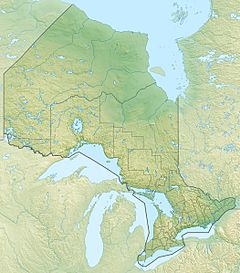Wolf River (Sudbury District) facts for kids
Quick facts for kids Wolf River |
|
|---|---|
|
Location of the mouth of the Wolf River in Ontario
|
|
| Country | Canada |
| Province | Ontario |
| Region | Northeastern Ontario |
| District | Sudbury District |
| Municipality | French River |
| Physical characteristics | |
| Main source | Unnamed lake 217 m (712 ft) 46°08′36″N 80°28′30″W / 46.14333°N 80.47500°W |
| River mouth | Lac Viau on the Wolseley River 187 m (614 ft) 46°08′26″N 80°21′27″W / 46.14056°N 80.35750°W |
| Basin features | |
| River system | Great Lakes Basin |
The Wolf River is a small river located in the French River area of Ontario, Canada. It flows through the Sudbury District in the northeastern part of the province. This river is part of the huge Great Lakes Basin, which means its waters eventually flow into the Great Lakes. The Wolf River is a "tributary" to the Wolseley River, meaning it flows into the Wolseley River.
Contents
Journey of the Wolf River
The Wolf River starts its journey from a lake that doesn't have a name. This lake is found in an area called Cosby Township. From there, the river flows towards the east.
River's Path
As the Wolf River moves, it passes by a couple of small communities. These are Noëlville and Chartrand Corner. After passing these places, the river changes direction. It turns and flows towards the northwest.
Where the River Ends
The Wolf River continues its path until it reaches a lake called Lac Viau. This lake is where the Wolf River joins the Wolseley River. The Wolseley River then flows into the French River. Finally, the French River empties into Georgian Bay, which is a part of Lake Huron. Lake Huron is one of the five Great Lakes.
Why Rivers Are Important
Rivers like the Wolf River are very important parts of our planet. They carry fresh water across the land. This water is vital for plants, animals, and people. Rivers also help shape the land over many years. They create valleys and carry nutrients that enrich the soil.
Rivers and Ecosystems
Rivers are home to many different kinds of plants and animals. Fish, insects, and birds all depend on rivers for their survival. The areas around rivers, called riparian zones, are also rich in wildlife. Protecting rivers helps protect these important ecosystems.


